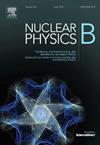左右对称模型中中微子的磁矩和i型和ii型跷跷板的相互作用
IF 2.8
3区 物理与天体物理
Q2 PHYSICS, PARTICLES & FIELDS
引用次数: 0
摘要
在左右对称模型中,假设已知狄拉克耦合矩阵的形式,马约拉纳耦合矩阵f以及右手中微子(RHN)质量矩阵有8个解。此外,耦合矩阵依赖于奇偶破落尺度vR,这是一种新的物理尺度。rhn在自然界中具有一个过渡磁矩(TMM)。中微子磁矩本质上与中微子质量相关,因为中微子质量意味着中微子磁矩。我们与小中微子TMM一起研究了重RHN跃迁磁矩对f的所有8个解的μ子g−2,(g−2)μ异常的贡献。我们发现,在8个解中,只有f矩阵的两个解对实验预测范围内的(g−2)μ有贡献。这些情况下的vR范围为3.4×103−1.5×104 GeV。为了补充检查,我们还研究了tmm诱导的中微子双β衰变(0νββ),对于相同的参数选择集。虽然某些参数选择允许RHNs解释(g−2)μ异常,但相同的配置导致0νββ衰变的半衰期非常长,远远超出实验范围。即使在极端磁场增强的情况下,半衰期也只是略微减少,这加强了弱相互作用顶点在0νββ衰变中对TMM贡献的优势。本文章由计算机程序翻译,如有差异,请以英文原文为准。
Magnetic moment of neutrinos in a left-right symmetric model and Interplay of type-I and type-II seesaw
In left-right symmetric models, the Majorana coupling matrix, f, and hence the right-handed neutrino (RHN) mass matrix, admits eight solutions assuming the form of the Dirac coupling matrix is known. Additionally, the coupling matrix depends on the parity-breaking scale, , as a new physics scale. RHNs being Majorana in nature can possess a transition magnetic moment (TMM). Neutrino magnetic moments are inherently related to neutrino masses, as neutrino masses imply neutrino magnetic moments. We study, along with small neutrino TMM, the heavy RHN transition magnetic moment contributions to muon , anomaly for all eight solutions of f. We find, of the eight solutions, only two solutions of f matrix contribute to the in the experimental predicted range. The range of in these cases is found to be GeV. For a complimentary check, we also study TMM-induced neutrinoless double beta decay (), for the same set of choice of parameters. While certain parameter choices allow RHNs to explain the anomaly, the same configurations lead to an extremely long half-life for decay, well beyond experimental reach. Even under extreme magnetic field enhancements, the half-life decreases only marginally, reinforcing the dominance of weak interaction vertices over TMM contributions in decay.
求助全文
通过发布文献求助,成功后即可免费获取论文全文。
去求助
来源期刊

Nuclear Physics B
物理-物理:粒子与场物理
CiteScore
5.50
自引率
7.10%
发文量
302
审稿时长
1 months
期刊介绍:
Nuclear Physics B focuses on the domain of high energy physics, quantum field theory, statistical systems, and mathematical physics, and includes four main sections: high energy physics - phenomenology, high energy physics - theory, high energy physics - experiment, and quantum field theory, statistical systems, and mathematical physics. The emphasis is on original research papers (Frontiers Articles or Full Length Articles), but Review Articles are also welcome.
 求助内容:
求助内容: 应助结果提醒方式:
应助结果提醒方式:


